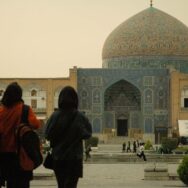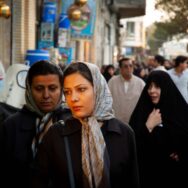I don’t think it’s possible for a thinking person to step onto the gorgeous courtyard of the 650-year-old Khargerd Ghiasieh School in northeast Iran and not feel both pity and amazement.

Amazement for the beauty of its iwans and the technical engineering devised to use nothing but desert winds to cool down the school’s 32 classrooms.
And pity for seeing this marvel of art and thoughtfulness disintegrate.
Khargerd Ghiasieh: An ancient school on the edge of the desert
Khargerd Ghiasieh was, at its time, a top university in Iran. The complex is now a tourist destination open for visits year-round. It is located outside the ancient town of Khargerd near the larger town of Khaaf (aka Khaf) in Razavi Khorasan Province in northeast Iran, about 100 KM or so west of the Afghanistan border.
The region is famous for its powerful winds coming in from desert flatlands. And the wind was what Artchitect Qavam ad-Din Shirazi used as air-conditioning.

Captured desert wind as motor-less AC
Once the school’s front gate is closed, the wind moves over and around the complex into the wind-catcher on the other side of the giant square structure. The wind-catcher funnels the wind into the courtyard.
The wind then blows into the classrooms through the grills on top of each room.
“I swear to you, in the middle of the summer it actually get’s cold in here!” exclaims Mohammad-Esmail Noparast, the lonely watchman at the school.

More about the Khargerd Ghiasieh
Europe was struggling towards the end of the Dark Ages when some of Iran’s best minds trained here in math, philosophy, astronomy and physics. The students spent the first six years on the bottom floor before they graduated to higher learning on the top floor, Noparast said.
Ghiasieh was commissioned by the Turkish Sultan Shahrokh Bahador Teimoori – the reason why many older locals still call it Shahrokh’s school.
It was ransacked by Russian troops in 1911. They paid the locals to break out much of its tiles to be hauled back to Russia, Noparast said.



It was registered as a national heritage of Iran in 1931. But it was on its way to destruction – “shepherds used to keep their animals here” – until in the 1970’s Mohammed Reza Pahlavi paid for its restoration, Noparast said.
Silence and Awe at Khargerd Ghiasieh
Beholding the grandeur of this jewel, it’s difficult to control my emotions. The kind of thinking that built this place also built the famous sites in Isfahan where 99-percent of foreign tourists end up.

To me, it’s proof the Iranian mind was different back then. Because there’s not a soul alive in Iran today who pays attention to much of anything – least of all sustainable and smart architecture. Most Iranians live in apartment buildings that rarely remain habitable beyond 25 years – at least not without major renovations.



In silence and awe, I look upward in the giant hall that was used as a mosque. The ancient muqarnas are still in perfect harmony designed by skill and thoughtfulness no longer in existence.




I’m taking pictures left and right and again I realize I’m mindlessly shooting duplicates. This happens a lot. I complain that Iran tour itineraries focus too much on old buildings. But then when I actually see the architecture Iranians were capable of, I get excited, stop complaining, and take way too many pics.
The tour guide is getting antsy and making noises about keeping a schedule. I don’t care. I curse the fact that I can’t just spend the entire day walking these halls. All I can do is shoot as much as I can and sort it out later.

Khargerd Ghiasieh is also known as Qiasieh School, Khargard School, Khar Gerd Historical School, Ghiaasieh khargerd, Ghiasieh Shahrokh Mosque, Qiyasieh Shahrokh Mosque.
Artchitect Qavam ad-Din Shirazi also built the beautiful Goharshad Mosque located in Imam Reza Shrine in Mashhad.





















































































Leave a Reply